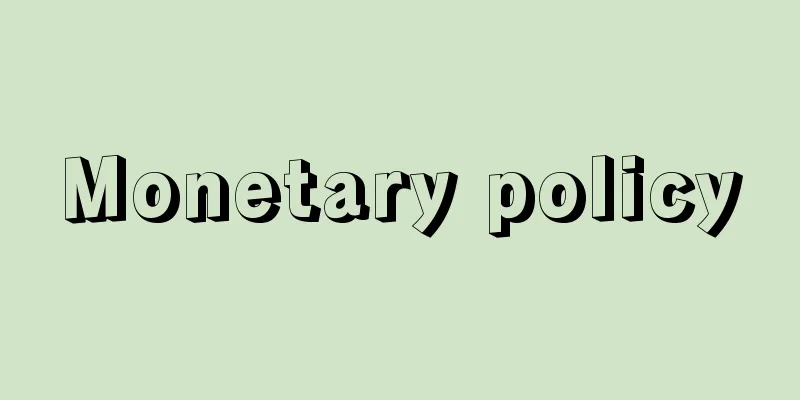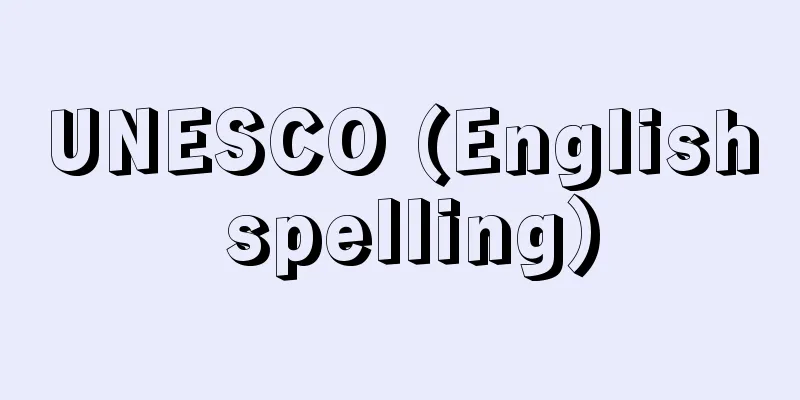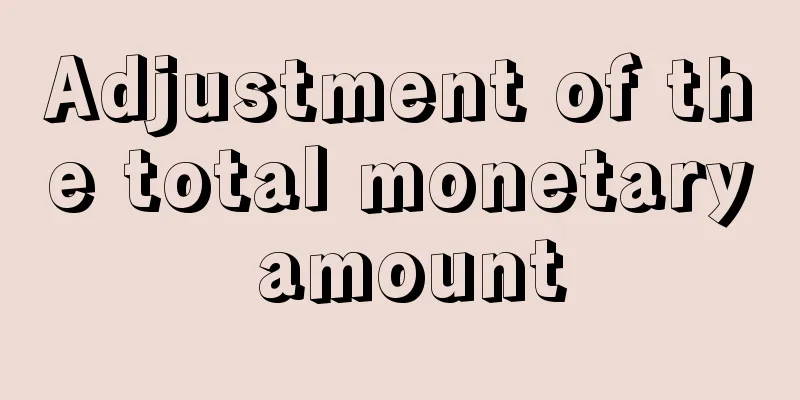Monetary policy

|
An economic policy implemented by each country's central bank with the aim of stabilizing prices by adjusting interest rates and money supply, and contributing to the healthy development of the national economy. [Shirai Sayuri December 12, 2016] Japan's Monetary PolicyTraditional Monetary Policy FrameworkThe Bank of Japan's Policy Board decides on the monetary policy policy for money market operations at its monetary policy meeting, and the Bank of Japan guides short-term market interest rates by supplying or absorbing funds (open market operations) to the financial market on a daily basis in line with the policy. Generally, short-term interest rates are often used as the target for money market operations, and these interest rates are also called the "policy interest rate." The Bank of Japan has adopted the unsecured call rate (overnight). The main means of supplying funds include pooled collateral funds supply operations (supplying funds by lending to financial institutions using government bonds as collateral), asset purchase operations (supplying funds by purchasing government bonds and treasury discount bills), and government bond purchase operations (supplying funds by purchasing government bonds and treasury discount bills on a predetermined date with a resale agreement). On the other hand, the main means of absorbing funds include bill sales operations (absorbing funds by selling bills issued by the Bank of Japan), government bond sales operations under repurchase agreements (absorbing funds by selling government bonds held by the Bank of Japan with a repurchase agreement on a predetermined date), and treasury bill sales operations. Another lending system is the "Complementary Lending Scheme" (Lombard Lending Scheme). This is a system in which funds are passively provided at any time within the limits of collateral upon receiving a borrowing application from a financial institution, and the lending period is one business day. The applicable interest rate has been maintained at 0.3% per annum since December 2008. Since it is unlikely that financial institutions would raise funds from the financial market at a higher interest rate, this interest rate forms the upper limit of short-term market interest rates. The "Complementary Current Account Facility" is a system that pays interest on "excess reserves," which are current account deposits accepted by the Bank of Japan, excluding "required reserves" (the amount of deposits at financial institutions to which the reserve ratio is applied). Since the Complementary Current Account Facility was introduced in 2008, the interest rate applied was 0.1% per year until the introduction of a negative interest rate was announced at the Monetary Policy Meeting at the end of January 2016, and was implemented on February 16th the following year. The applicable interest rate of the Complementary Lending Facility and the interest rate applied under the Complementary Current Account Facility form the upper and lower limits of interest rates in financial markets, respectively, and since the unsecured call rate, which is the subject of manipulation, tends to move within these ranges, these two interest rates are called a "corridor." [Shirai Sayuri December 12, 2016] Introduction of a price stability targetAt the Monetary Policy Meeting in January 2013, under Governor Masaaki Shirakawa, a 2% year-on-year increase in the Consumer Price Index (CPI) was adopted as the price stability target. At that time, the conceptual definition of price stability was explained as a situation in which households and businesses can make decisions regarding economic activities such as consumption and investment without being bothered by fluctuations in the price level of goods and services in general, and which is consistent with sustainable economic growth. Based on this understanding, the Bank promised to achieve this target as soon as possible. The reason for adopting the CPI as the policy target was that it is an index that comprehensively covers goods and services consumed by households, is in line with the actual feelings of the people, is easily reported, and has a long five-year revision cycle. [Shirai Sayuri December 12, 2016] Unconventional monetary policyIn the early 1990s, the economy experienced the so-called "bubble burst" in real estate and stocks, and then faced a financial crisis in the late 1990s. Although there was a temporary economic recovery during this period, the economy fell into a long-term recession and a negative supply-demand gap (i.e., a state of demand shortage). The growth rates of both the CPI and "core CPI" (an index excluding fresh food from the CPI) continued to decline, and from around 1998, the economy entered a period of mild negative growth (i.e. deflation). In this environment, the following unconventional policies were adopted: [Shirai Sayuri December 12, 2016] Before the introduction of “Quantitative and Qualitative Monetary Easing” (February 1999 to March 2013)[1] Zero interest rate policy (February 1999 to August 2000) The so-called "zero interest rate policy" was introduced, which encouraged the unsecured overnight call rate to remain as low as possible and, while paying close attention to maintaining the function of the short-term financial market so as not to cause confusion, initially aimed for around 0.15%, and then gradually encouraged a further decline while taking into account market conditions. In addition, monetary easing was strengthened by clarifying the policy to continue the zero interest rate policy until "the situation is such that deflationary concerns can be expected to be dispelled." This method of indicating future monetary easing policies is called "forward guidance." In August 2000, the downward pressure on prices due to weak demand had greatly receded, and it was determined that the situation had reached "the situation is such that deflationary concerns can be expected to be dispelled," which is the condition for lifting the zero interest rate policy, so it was lifted and the unsecured overnight call rate was raised to around 0.25%. However, there are many who believe that the decision to lift the zero interest rate policy at that time was premature, as the country had not yet escaped from deflation. [2] Quantitative easing (March 2003 to March 2006) Following the collapse of the American IT bubble in 2000, exports and production in Japan fell sharply, and prices continued to fall. As a result, the Bank of Japan decided to introduce a "quantitative easing" policy in March 2001. At the time, the unsecured overnight call rate, which is the target of the money market adjustment policy, was already close to zero percent, and it was determined that interest rates could not be lowered any further, so quantitative easing was decided upon. Quantitative easing has the following characteristics: (1) Change in the target for money market operations: The target was changed from the unsecured overnight call rate to the current account balance at the Bank of Japan. The target amount was raised nine times from the initial 5 trillion yen to 30-35 trillion yen in January 2004, and was maintained at that amount until the end of quantitative easing. This target amount was achieved mainly by repeating short-term money supply operations with a maturity of less than one year. It was also decided to increase government bond purchases if necessary. (2) Clarification of the policy regarding the continuation of quantitative easing: The Bank of Japan promised to maintain quantitative easing "until the year-on-year rate of increase in the core CPI is stably at or above zero percent." This is the so-called forward guidance. In October 2003, this policy was made clearer, and the conditions for an exit were stated as follows: first, the most recently published year-on-year rate of increase in the core CPI must be at or above zero percent, not just in a single month, but also be judged to be at or above zero percent as a fundamental trend; and second, the year-on-year rate of increase in the core CPI must not be expected to become negative again in the future (it is necessary that many members have a forecast that it will exceed zero percent). However, it was also clarified that these conditions are necessary, and that depending on the economic and price situation, it may be judged appropriate to continue quantitative easing even if these conditions are met. In November 2005, the year-on-year rate of increase in the core CPI turned positive (the CPI turned positive in January 2006). The Bank of Japan then concluded that all the conditions for ending quantitative easing had been met in March 2006 and ended it, returning the target of money market operations to the uncollateralized call rate and initially setting a target of roughly zero percent. However, in August 2006, the base year for the CPI was revised from 2000 to 2005, and the growth rate, which had been positive up until then, was revised to negative, and it became clear in retrospect that the conditions for ending were not met. The downward revision of the CPI was considerably larger than past trends and exceeded the Bank of Japan's forecasts, but there was criticism that the Bank should have waited until the CPI was revised before deciding to end it, and that the decision to end it was premature. [3] Comprehensive monetary easing (October 2010 to March 2013) Against the backdrop of the economic downturn following the Lehman Shock, the Bank of Japan decided to introduce a comprehensive monetary easing policy in October 2010. At the same time, it changed the unsecured overnight call rate, which is the interest rate target in the money market adjustment guidelines, from around 0.1% to around 0-0.1%, effectively adopting a zero interest rate policy. Comprehensive monetary easing has the following characteristics: (1) Policy regarding the continuation of monetary easing: The committee agreed to continue the virtually zero interest rate policy until the situation allows for the prospect of price stability based on the "understanding of medium- to long-term price stability" (forward guidance). The understanding of medium- to long-term price stability was expressed as the year-on-year increase rate of the CPI being "in the positive range of 2% or less, with the majority of committee members centering around 1%." Furthermore, in February 2012, the policy underwent a major change. The "understanding" of medium- to long-term price stability was changed to a "target" (translated as "goal" in English), which means that the committee members have progressed from "understanding," which covers the views of each committee member, to adopting a "target" which indicates the agreement of all committee members. Based on this, the target was defined as "in the positive range of 2% or less," with "a target of 1% for the time being," and the target was to be checked annually in principle. Furthermore, the policy was strengthened by stating, "We will pursue powerful monetary easing through measures such as a virtually zero interest rate policy and the purchase of financial assets through the Asset Purchase Program, aiming for a 1% inflation rate until this is in sight." Furthermore, it was made clear that the continuation of monetary easing will be conditional on examining risk factors, including the accumulation of financial imbalances, and on the condition that no problems arise from the perspective of ensuring sustainable economic growth. (2) Introduction of the Asset Purchase Fund: The assets purchased consisted of government bonds (with remaining maturities of 1 to 3 years), treasury bills, corporate bonds, commercial paper (CP), index-linked exchange-traded funds (ETFs), and Japan Real Estate Investment Trusts (J-REITs). The existing 3-month and 6-month "fixed-rate pooled collateral funds-supplying operations" were continued. The balance of the fund, including these, was initially decided to be increased to 35 trillion yen by the end of 2011, but was subsequently raised several times, and was scheduled to be increased to 101 trillion yen by the end of 2013 and 111 trillion yen by the end of 2014. However, the excessive appreciation of the yen and mild deflation continued, and criticism intensified that these monetary easing measures were insufficient to achieve the price stability target of a 2% year-on-year increase in the CPI, which was set in January 2013. [Shirai Sayuri December 12, 2016] After the introduction of “Quantitative and Qualitative Monetary Easing” (from April 2013)In April 2013, at the first monetary policy meeting of Haruhiko Kuroda, who had just assumed the post of Governor in late March, an unconventional "quantitative and qualitative monetary easing" policy was adopted in order to achieve the price stability target of a 2% year-on-year increase in the CPI as soon as possible, with a time frame of about two years in mind. It is also known as "quantitative and qualitative easing," "Kuroda bazooka," and "ultra-easing." Under this policy, the operating target of the monetary adjustment policy was changed from the unsecured call rate to the "monetary base" in order to promote quantitative monetary easing. The monetary base is the sum of the current account deposits at the Bank of Japan, the amount of banknotes issued by the Bank of Japan, and the amount of currency in circulation. In April 2013, the Bank of Japan conducted financial market adjustments to increase the monetary base at a pace equivalent to about 60 trillion to 70 trillion yen per year, but in October 2014, the increase in the monetary base was increased to an annual pace equivalent to about 80 trillion yen. [1] Quantitative and Qualitative Monetary Easing In "quantitative and qualitative monetary easing" (QQE), "quantitative easing" refers to the increase in the monetary base, which is the operating target of the financial market adjustment guidelines. Since monetary easing aimed at expanding the amount requires a large supply of funds, the main means of supplying funds is to purchase large amounts of government bonds rather than lending to banks. Government bonds of all maturities, from one year or less to a maximum of 40 years, are purchased, and the initial policy was to purchase long-term government bonds at a pace equivalent to about 50 trillion yen per year, but in October 2014 the pace of purchases was increased to increase the balance of long-term government bonds held at a pace equivalent to about 80 trillion yen per year. "Qualitative monetary easing" refers to economic policies that purchase risky assets and extend the average remaining maturity of government bond purchases. In order to push down the risk premium of asset prices (the excess yield that investors demand compared to government bonds), the Bank of Japan purchased large amounts of ETFs and J-REITs as risky assets. The annual amount of ETF purchases was increased from about 1 trillion yen in April 2013 to about 3 trillion yen in October 2014, and further to about 6 trillion yen in July 2016 (of this amount, 300 billion yen is equivalent to the amount of about 300 billion yen sold per year over 10 years from April 2016 for the unsold stocks purchased from financial institutions in 2002, and approximately the same amount of ETFs will be purchased to offset the impact of the sales on the stock market). The annual amount of J-REIT purchases was increased from about 30 billion yen in April 2013 to about 90 billion yen in October 2014. As for corporate bonds and commercial paper, the Bank reinvested them to maintain the balance of assets purchased under the Comprehensive Monetary Easing. Meanwhile, the average remaining maturity of government bonds purchased was lengthened from about seven years (six to eight years) in April 2013 to about seven to ten years in October 2014, and to about seven to 12 years in December 2015. [2] Quantitative and qualitative monetary easing with negative interest rates In January 2016, in addition to quantitative and qualitative monetary easing, the Bank of Japan introduced a negative interest rate policy as a new policy tool, which has since been called "quantitative and qualitative monetary easing with negative interest rates." The Bank of Japan aimed to achieve its price stability target of a 2% year-on-year increase in the CPI as soon as possible by utilizing three-dimensional monetary easing tools: "quantity," "quality," and "interest rate." The "interest rate" here refers to negative interest rates. Specifically, the Bank of Japan divides current accounts into three categories (basic balance, macro-additional balance, and policy interest rate balance), and applies annual interest rates of 0.1%, 0%, and -0.1% to each of these, but the "-0.1%" refers to the interest rate applied to the policy interest rate balance. As of 2016, negative interest rates were only being applied to a very small portion of the Bank of Japan's current account deposits (10 trillion to 30 trillion yen). However, they are being applied to newly added current account deposits, and because negative interest rates mean that financial institutions are paying interest to the Bank of Japan, it is thought that this will create an incentive for financial institutions to reduce their current account deposits with the Bank of Japan and increase lending instead. The three-tiered system for the Bank of Japan's current accounts was introduced with reference to the examples of countries such as Switzerland, Sweden, and Denmark, which have various forms of exemptions from negative interest rates, in order to prevent the application of negative interest rates from excessively squeezing the profits of financial institutions and weakening their financial intermediation functions. However, in Japan's case, the pace of increase in current accounts due to large amounts of government bond purchases is so rapid that it places a heavy burden on financial institutions' interest burden. For this reason, efforts were made to reduce financial institutions' interest burden by introducing a mechanism to transfer a certain amount from the policy interest rate balance to the macro add-on balance, but this resulted in a complex system that was difficult to understand by the market and the public, leaving issues unsolved. The application of negative interest rates was expected to lower the starting point of the yield curve by making it easier for interbank transactions to be concluded at negative interest rates in the short-term financial market. Combined with the large-scale government bond purchases that had been continuing until then, it was expected that strong downward pressure on the entire yield curve would lower real interest rates, expand total demand for consumption and investment, and thereby increase inflationary pressure. In addition, some companies were able to issue long-term corporate bonds at low interest rates. However, some side effects were pointed out. For example, banks' interest margins shrank because lending rates fell while deposit rates were already close to 0%, resulting in a decrease in bank profits amid sluggish lending. After the introduction of negative interest rates, many government bond yields became negative and the government bond yield curve became extremely flat, so while valuation gains and profits on sales of government bonds could be obtained in the short term, investment profits in the somewhat longer term decreased. The liquidity of government bonds also decreased due to the withdrawal of financial institutions and investors who could not manage with negative interest rates. [3] Policy for continuing quantitative and qualitative monetary easing with a negative interest rate The Bank of Japan decided to continue quantitative and qualitative monetary easing with a negative interest rate until the point at which it is necessary to achieve the price stability target of a 2% year-on-year increase in the CPI and to maintain this target stably. It also stated that it would examine risk factors for the economy and prices, and take additional easing measures in three dimensions - quantity, quality, and interest rates - if necessary to achieve this target. Risk factors for the economy and prices include financial imbalances such as hyperinflation, deflation, and the creation of bubbles, as well as reduced liquidity in the government bond market, and it decided to implement monetary policy management while examining these risks. (4) Other financing systems (2) Funding to support the strengthening of the foundations for growth: A mechanism to provide low-interest, long-term funds to financial institutions that invest in 19 areas that contribute to the growth of the Japanese economy (research and development, start-ups, business restructuring, tourism, environmental and energy businesses, medical, nursing, and health-related businesses, etc.) after verifying the details of the investments. In addition to the basic lending limit, there is a special limit for investments and ABL (asset-backed loans), a special limit for small amounts, and a special limit using US dollars. (3) Funding to support increased lending: A framework for providing low-interest, long-term funds to financial institutions that have increased their loan balances, up to twice the amount of the increase. There is no upper limit on the total amount of funds provided. [Shirai Sayuri December 12, 2016] US Monetary PolicyUnited States monetary policy is carried out by the Federal Reserve System (FRS), a uniquely American central banking system. The Federal Reserve System consists of the Board of Governors of the Federal Reserve System (FRB) and 12 Federal Reserve Banks. The FRB oversees the Federal Reserve System and is made up of seven Governors, including the Chairman and Vice Chairman. Monetary policy is decided by the 12 members of the Federal Open Market Committee (FOMC). The FOMC consists of the seven Governors of the FRB and the President of the Federal Reserve Bank of New York, and the other four members rotate among the remaining 11 Federal Reserve Banks and have voting rights. The Presidents of the Federal Reserve Banks, who do not have voting rights, also participate in discussions on monetary policy management. All 19 members present economic and price forecasts four times a year. [Shirai Sayuri December 12, 2016] The Fed's response to the subprime crisisThe 2008 subprime crisis was different from a simple banking crisis based on a normal surge in credit lending. It involved a wide range of complex financial products, such as mortgage-backed securities (MBS), credit default swaps (which are insurance contracts for MBS), and other asset-backed securities (ABS), in a large financial system that included various nonbanks, and was a major financial crisis that had a systemic chain reaction in Europe and other countries. In March 2008, the Federal Reserve was involved in the merger of JPMorgan Chase to rescue the investment bank Bear Stearns, and later rescued the giant insurance company AIG. The Federal Reserve pointed out that the reason for bailing out Bear Stearns and AIG was that these nonbanks were large and systemically linked to other financial institutions and products, and that they were not insolvent. On the other hand, the Federal Reserve explained that it allowed the collapse of the investment bank Lehman Brothers was because it was insolvent and that it judged that it did not have the authority to bail out the bank. However, the collapse of Lehman Brothers developed into the Lehman Shock and into a global financial crisis. When funds dried up in the US short-term money market, the Fed boldly supplied large amounts of funds to non-banks, money market mutual funds (MMMFs), commercial paper (CP) markets, etc. Until then, funds had flowed into MMMFs as deposit-like products, mainly from individual investors, but since the Lehman Shock triggered a rapid outflow of funds, the Fed supplied funds to prevent the spread of the financial crisis due to the fire sales of assets by MMMFs. The CP market is the main short-term funding market for broker-dealers, asset-backed securities (ABS) issuers, and other financial institutions. Since MMMFs were the providers of funds, they also supplied funds to asset-backed securities issuers, etc., in order to prevent the outflow of funds from MMMFs from causing a ripple effect by causing the issuers to run out of funds and spreading the crisis. The Fed also lent government bonds and other securities held by the Fed. These liquidity measures allow the Fed to be viewed as acting as a lender of last resort. [Shirai Sayuri December 12, 2016] Adoption of unconventional monetary policiesIn September 2007, the FRB also rapidly lowered the federal funds rate (policy interest rate), which was 5.25% at the time, and by December 2008, the rate had reached a record low of 0-0.25%. At this stage, the FRB determined that there was little room for further rate cuts, and indicated a policy of maintaining low interest rates for a long time (forward guidance), and further implemented an unconventional monetary easing policy by purchasing assets. The assets purchased were U.S. Treasury bonds and MBS and bonds issued by government agencies and government-sponsored organizations known as agencies. After that, in May 2013, Chairman Bernanke, with the economic situation favorable, suggested the possibility of tapering the amount of asset purchases toward the end of the year. However, this caused a big negative surprise in the market, and interest rates soared. This is generally called the "Taper Tantrum". However, since then, the economy has strengthened its recovery, the employment improvement has been remarkable, and the unemployment rate has fallen faster than expected, so the FOMC decided to reduce the amount of asset purchases without causing any major confusion in the market in December 2013, and decided to implement it from January 2014 (Bernanke's last meeting as Chairman). The reduction in the amount of asset purchases ended in October of the same year, and reinvestment to maintain the balance of assets held continued. In December 2015, the first interest rate hike was made under new Chair Janet Yellen, raising the federal funds rate from 0-0.25% to 0.25-0.5%. [Shirai Sayuri December 12, 2016] EU Monetary PolicyThe monetary policy of the European Union (EU) is implemented by the European Central Bank (ECB) and the European System of Central Banks (ESBC), which consists of the central banks of the 19 countries that use the common currency, the euro. The objective is to achieve price stability in the euro area and maintain the purchasing power (currency value) of the euro. Price stability is defined as an inflation rate of "less than 2% or close to 2%." [Shirai Sayuri December 12, 2016] ECB response after the global financial crisisWhen the Lehman Shock developed into the Global Financial Crisis, the Eurozone faced a banking crisis. The ECB aggressively lowered its policy interest rate (main refinancing rate) from 4.25% in October 2008 to 1% in May 2009. It also expanded its fund supply operations to lend longer-term funds than usual and introduced a mechanism to supply the full amount of bids at a fixed interest rate. In early 2010, the euro debt crisis that began in Greece worsened, and investors became worried that these debtor countries (peripheral countries) would default and be forced to withdraw from the euro, raising concerns about the collapse of the euro. The ECB then introduced the Securities Market Program, which purchased a limited amount of government bonds from peripheral countries between May 2010 and March 2012, and purchased a total of 220 billion euros worth of securities. In addition, between 2009 and 2012, the Bank introduced the Covered Bond Purchase Programme, purchasing secured securities worth a total of 10 billion euros. [Shirai Sayuri December 12, 2016] OMT Introduction and LitigationAfter that, as the euro debt crisis worsened again, ECB President Mario Draghi stated in July 2012 that "we are ready to do anything to protect the euro," and announced the Outright Monetary Transactions (OMT) program in August immediately after, and made OMT available the following September. OMT purchases government bonds with remaining maturities of one to three years on the condition that eurozone member states implement economic or preliminary programs of the European Union (EU) and the International Monetary Fund (IMF). In the end, OMT was never used, but it sent a strong message to the market that it was possible to purchase unlimited amounts of Spanish and Italian government bonds if necessary, which subsided the speculative attacks that could have led to the risk of the euro collapsing. This response is highly regarded for contributing to the stabilization of the eurozone financial markets. However, a lawsuit was filed with the German Constitutional Court alleging that OMT violated the German Constitution and the EU Treaty, and the German Constitutional Court referred the matter to the European Court of Justice for a ruling on whether OMT was illegal under the EU Treaty. In January 2015, the Advocate General of the European Court of Justice ruled that OMT is, in principle, legal, although certain conditions must be met. In response, the European Court of Justice issued a final ruling in June 2015 that OMT is legal. Then, in June 2016, the German Constitutional Court ruled that the ECB could implement OMT without violating the German Constitution if six conditions were met. These conditions include that the government bond issuance environment is not distorted and the purchase price is limited from the start. Additionally, two three-year long-term funding operations (LTRO) were conducted in December 2011 and February 2012, which contributed to lower costs for banks in the eurozone peripheral countries to raise funds. [Shirai Sayuri December 12, 2016] Starting a full-scale non-traditional monetary policyAfter that, concerns about the prolonged low inflation, a decline in expected inflation rate, a shrinking bank asset rate, and a strong euro, the ECB began a comprehensive monetary easing policy since June 2014. The ECB applied a negative interest rate to the ECB's deposit facility interest rate, to a negative 0.1% in June 2014, and then gradually reduced to a negative 0.4% in March 2016. Initially, a negative interest rate policy was introduced to avoid asset purchases, and after the decision to purchase assets, it was limited to asset-backed securities (ABS) and covered bonds. However, due to the continued decline in the expected inflation rate, and the prolonged low inflation caused concerns that real interest rates would rise and deflation would rise, the company announced its large-scale asset purchase policy in January 2015, and it began in March of the same year. The assets purchased are gradually expanding, and as of November 2016, it has pledged to purchase 80 billion euros per month, including government bonds, government agency bonds, international agency bonds, local government bonds, corporate bonds, etc. until March 2017. When purchasing assets, restrictions are imposed on the lower limit of purchase prices, upper limit of purchase amounts, and the method of allocation of government bonds for each country, and these restrictions are in good agreement with the conditions pointed out in the aforementioned ruling of the European Court of Justice. In addition, in September 2014, the company introduced a targeted long-term loan system (TLTROI) that lends long-term funds at a low interest rate based on its track record of private lending, and implemented it quarterly until June 2016. Based on the record of banks' loans to private lending, the ECB lends up to three times that amount at a low loan interest rate (0% from March 2016). The difference between LTRO and LTRO is that ECB lends to banks with funding provisions based on the record of private lending by banks, which prevents the banks from using funding funds raised from the ECB from purchasing government bonds and other such as government bonds rather than lending. The time when banks borrow from the ECB is set to September 2018. Furthermore, TLTRO II was introduced in March 2016, with the loan period fixed for four years, and banks that increase private lending at a certain level or higher will be able to receive funding at a lower loan interest rate (the minimum interest rate is the deposit facility interest rate, which is minus 0.4% as of November 2016). になったんです。 English: The first thing you can do is to find the best one to do. [Shirai Sayuri December 12, 2016] China's monetary policyになったんです。 English: The first thing you can do is to find the best one to do. [Shirai Sayuri December 12, 2016] Capital outflow and shift to expectations for the yuan weakになったんです。 English: The first thing you can do In this context, capital outflows from mainland China have been ongoing since around 2014, and the long-running pressure on the yuan and expectations of the yuan's high yuan have been seen, and a major shift has been seen from the US's tapering of asset purchases in 2014, and the US interest rates skyrocketed, as well as the fact that Chinese companies rushed to repay short-term dollar-denominated debts due to expectations of a strong dollar, and Chinese companies have been strengthening their stance to keep a portion of their overseas profits overseas without releasing them to mainland China. [Shirai Sayuri December 12, 2016] The yuan devaluation in 2015Since March 2014, the People's Bank of China had been guiding the yuan against the dollar to move daily within the 2% of the mid-mid-mid-value. The mid-mid-value of the yuan was set every morning in the early hours of the morning, but the correlation between the closing price on the previous day was low, and it was thought to mainly reflect the policy intentions of the People's Bank of China. However, the deviation between the market's actual market (for example, the closing price on the previous day) and the mid-mid-value has grown, exceeding 3%. Deemed impossible to sustain such a deviation, the yuan was cut down to reduce the deviation, and the mid-value against the dollar was cut down by 4.5% for three consecutive days from August 11 to 13, 2015. However, this decline exceeded the range of fluctuations in the previous exchange rate, causing a shock to the yuan. The policy decision itself was appropriate, but exports were sluggish and the problem of overproduction of steel, cement, etc. was serious, and the sudden devaluation of the yuan without sufficient external explanations led to the world misunderstanding that China intended to promote exports by guiding the yuan weakening, leading to the destabilization of global financial markets. With the stock price falling since the end of July of the same year, concerns about the Chinese economy and distrust of the Chinese government's policy intentions increased, leading to countries around the world taking a risk-averse stance. になったんです。 English: The first thing you can do is to find the best one to do. Furthermore, the Chinese financial markets became more tempered as the yuan was absorbed from the market due to the reversal of foreign currency reserves, mainly the dollar. Therefore, the People's Bank of China strived to ease monetary easing by lowering the deposit reserve rate applied to bank deposits, lowering the base interest rate, and implementing large amounts of funding operations. However, the People's Bank of China continued its easing measures as if the interest rate gap was narrowed due to significant monetary easing could lead to further capital outflows and the problem of overproduction, overinvestment and overdebt could worsen again. The economic measures to combat the economic slowdown were mainly focused on government infrastructure investments and promotion of home purchases. After that, the foreign exchange and stock markets also regained their calm due to the strict application of existing capital regulations by Chinese authorities and various interventions. [Shirai Sayuri December 12, 2016] Renminbi onshore and offshore marketsChina's financial markets include onshore markets (mainland China markets) and offshore markets (mains outside the mainland China, mainly Hong Kong (Hong Kong). These markets are divided by capital regulations, so the yuan markets include onshore (CNY) and offshore (CNH). The People's Bank of China is paying attention to CNY in its monetary policy management, but overseas investors are paying attention to CNH, which is more likely to reflect supply and demand. For example, in situations where expectations for a weaker yuan are rising, CNH tends to have a weaker yuan than CHY. [Shirai Sayuri December 12, 2016] Yuan SDR currency basket includedになったんです。 English: The first thing you can do is to find the best one to do. The Chinese government applied for a review of the SDR currency basket in 2010, but at the time it was determined that it did not meet the conditions of "freely used currencies" and was not adopted. Freely available currencies are not synonymous with currencies that have no capital regulations and can be exchanged completely freely, such as the dollar or euro. In emerging countries such as China, international banking transactions and bond issuance have not yet been developed sufficiently, and capital regulations remain, so it is difficult to request the same conditions as developed countries. The IMF, which intends to increase the number of basket currencies, has decided to set a new standard there. Specifically, it has decided to focus on whether the national currency is held as assets in the foreign currency reserves held by central banks of each country, whether the trading volume of the national currency is increasing in the spot market and derivative market in the foreign exchange market, and whether interest rates are being marketed. Since 2000, China has been promoting the liberalization of financial and capital markets, such as the elimination of the upper limit of domestic deposit interest rates, the expansion of access to China's capital markets by foreign investors, the promotion of foreign direct investment by Chinese companies, and the promotion of the use of the yuan in trade settlements. In addition, the company has actively concluded bilateral currency swap agreements with more than 20 central banks, and has focused on creating offshore centres for the yuan, and as a result, central banks from each country gradually increased the use of the yuan and the yuan. It is believed that the IMF has evaluated the degree of progress and domestic financial and capital market reforms. [Shirai Sayuri December 12, 2016] [Reference Items] | | | | | | | | | Rate | | | | | | Guidance | | | | | | |Source: Shogakukan Encyclopedia Nipponica About Encyclopedia Nipponica Information | Legend |
|
各国の中央銀行が、金利や通貨供給量を調整することで物価の安定を図り、国民経済の健全な発展に資することを目的として実施する経済政策。 [白井さゆり 2016年12月12日] 日本の金融政策伝統的な金融政策の枠組み日本銀行政策委員会の金融政策決定会合において金融市場調節方針が決定され、その方針に沿って日本銀行が金融市場に対して資金供給または資金吸収(公開市場操作、オペレーション)を日々実施することで、短期の市場金利を誘導する。一般的に、金融市場調節の操作対象として短期金利を採用することが多く、その金利は「政策金利」ともよばれる。日本銀行では無担保コールレート(オーバーナイト物)を採用してきた。おもな資金供給手段として、共通担保資金供給オペレーション(国債などを担保にとって金融機関へ貸し付けて資金供給)、資産買入れオペレーション(国債や国庫短期証券などを買い入れて資金供給)、国債買現先(かいげんさき)オペレーション(国債や国庫短期証券をあらかじめ定めた期日に売戻し条件付きで買い入れて資金供給)などがある。一方、おもな資金吸収手段としては、手形売出しオペレーション(日本銀行が振り出した手形を売却して資金吸収)、国債売現先オペレーション(日本銀行が保有する国債などをあらかじめ定めた期日に買戻し条件付きで売却して資金吸収)、国庫短期証券の売却オペレーションなどがある。 その他の貸付制度として「補完貸付制度」(ロンバート型貸出制度)がある。金融機関からの借り入れ申請を受けて、担保の範囲内でいつでも受動的に資金を融通する仕組みで、貸付期間は1営業日である。適用利率は、2008年(平成20)12月以降、年0.3%が維持されている。金融機関はこれより高い金利で金融市場から資金調達をするとは考えにくいため、同利率が短期の市場金利の上限を形成している。 また、「補完当座預金制度」は、日本銀行が受け入れる当座預金などのうち、「所要準備額」(金融機関の預金に対して預金準備率が適用される金額)を除いた、「超過準備額」に対して利息を付す制度である。2008年に補完当座預金制度が導入されて以降、付利は2016年1月末の金融政策決定会合でマイナス金利の導入を発表し、翌2月16日に実施するまでは、年0.1%が適用されてきた。補完貸付制度の適用利率と補完当座預金制度の付利が、それぞれ金融市場の金利の上限と下限を形成し、操作対象である無担保コールレートがこの範囲内で推移する傾向があることから、これら二つの金利は「コリドー(回廊)」とよばれる。 [白井さゆり 2016年12月12日] 物価安定目標の導入2013年1月の金融政策決定会合において、総裁白川方明(しらかわまさあき)のもとで、物価の安定目標として消費者物価指数(CPI)の対前年比上昇率2%が採用された。その際、物価の安定の概念的な定義として、家計・企業などが「財・サービス全般の物価水準の変動に煩わされることなく、消費や投資などの経済活動にかかる意思決定を行うことができる状況」であり、かつ経済の持続的な成長と整合的であることと説明している。こうした理解のもとで、同目標をできるだけ早期に実現すると約束した。政策目標として消費者物価指数を採用したのは、国民の実感に即した、家計が消費する財・サービスを包括的にカバーした指標であり、しかも速報性が高く、基準改定が5年周期と長いことなどを重視したためである。 [白井さゆり 2016年12月12日] 非伝統的な金融政策1990年代初めに不動産と株式などのいわゆる「バブル崩壊」を経験し、その後1990年代後半に金融危機に直面した。この間、一時的な景気回復局面がみられたものの、長期にわたって景気後退とマイナスの需給ギャップ(すなわち、需要不足状態)に陥った。CPIと「コアCPI」(CPIから生鮮食品を除いた指数)ともに伸び率が低下を続け、1998年(平成10)ころからは緩やかなマイナス(すわなちデフレ)が続くようになった。そうしたなかで、以下の非伝統的政策が採用されるに至っている。 [白井さゆり 2016年12月12日] 「量的・質的金融緩和」導入以前(1999年2月~2013年3月)〔1〕ゼロ金利政策(1999年2月~2000年8月) 無担保コールレート(オーバーナイト物)をできるだけ低めに推移するよう促し、短期金融市場に混乱の生じないようその機能の維持に十分配意しつつ、当初は0.15%前後を目ざし、その後は市場の状況を踏まえながら徐々に一層の低下を促すという、いわゆる「ゼロ金利政策」を導入。また、「デフレ懸念の払拭(ふっしょく)が展望できるような情勢」となるまでゼロ金利政策を継続するとの方針を明確化することで金融緩和を強化した。こうした将来の金融緩和方針を示す手法は、「時間軸政策」、または「フォワードガイダンス」とよばれる。2000年8月に需要の弱さによる物価低下圧力は大きく後退し、ゼロ金利政策の解除の条件である「デフレ懸念の払拭が展望できるような情勢」に至ったと判断してこれを解除し、無担保コールレート(オーバーナイト物)を0.25%前後へと引き上げた。しかし、このときのゼロ金利政策解除の判断については、デフレから脱却していないなかで早過ぎたとの見方が少なからずある。 〔2〕量的緩和(2003年3月~2006年3月) 2000年のアメリカITバブル崩壊によって日本では輸出と生産が大きく減少し、物価の下落が続いてきた。そのため、日本銀行は2001年3月に「量的緩和」政策の導入を決定した。このとき、金融市場調節方針の操作対象である無担保コールレート(オーバーナイト物)はすでにゼロ%近くにあり、これ以上金利は下げられないと判断し、量的緩和を決定した。量的緩和には次の特徴がある。 (1)金融市場調節の誘導目標の変更:無担保コールレート(オーバーナイト物)から、日本銀行当座預金残高に変更。目標額は当初の5兆円程度から9回引き上げられて2004年1月には30兆~35兆円程度に達した後、量的緩和の解除まで同目標額を維持した。この目標額はおもに期間1年以内の短期の資金供給オペレーションを繰り返すことで達成された。また、必要があれば国債買入れを増額することも決定した。 (2)量的緩和の継続についての方針の明確化:日本銀行は、「コアCPIの対前年比上昇率が安定的にゼロ%以上となるまで」量的緩和を維持すると約束した。いわゆるフォワードガイダンスである。2003年10月にこの方針をより明確化し、出口の条件として、第一に、直近公表のコアCPI対前年比上昇率が単月でゼロ%以上となるだけでなく、基調的な動きとしてゼロ%以上であると判断できることが必要であるとし、第二に、コアCPI対前年比上昇率が先行きふたたびマイナスになると見込まれないことが必要(多くの委員がゼロ%を超える見通しを有していることが必要)であるとした。ただし、これらの条件は必要条件であって、経済・物価情勢によっては、これらの条件を満たしたとしても量的緩和の継続が適当と判断される場合もあるとも明記した。 2005年11月にコアCPIの対前年比上昇率はプラスに転じた(CPIは2006年1月にプラスに転換)。そこで、日本銀行は2006年3月に量的緩和解除の条件がすべて満たされたと判断してこれを解除し、金融市場調節の操作対象を無担保コールレートに戻して当初はおおむねゼロ%の誘導目標を設定した。もっとも、2006年8月にはCPIの基準年が2000年から2005年に改定され、それまでプラスの値とされた伸び率がマイナスに修正されたため、事後的にみれば解除条件を満たしていなかったことが判明した。CPIの下方修正は過去のトレンドと比べてかなり大きく、日本銀行の予測を超えるものではあったが、解除については、CPIの改定を待って判断すべきだったとの批判や、解除の決定は早計だったとの批判も聞かれた。 〔3〕包括的金融緩和(2010年10月~2013年3月) リーマン・ショック後の景気後退を背景にして、2010年10月に包括的金融緩和政策の導入を決定した。同時に、金融市場調節方針における金利誘導目標である無担保コールレート(オーバーナイト物)を0.1%程度から0~0.1%程度に変更して、実質的なゼロ金利政策を採用した。包括的金融緩和は次のような特徴をもつ。 (1)金融緩和の継続についての方針:「中長期的な物価安定の理解」に基づく物価安定が展望できる情勢になるまで、実質的なゼロ金利政策を継続するとの約束を取り決めた(フォワードガイダンス)。中長期的な物価安定の理解とは、CPIの対前年比上昇率が「2%以下のプラスの領域にあり、委員の大勢は1%程度を中心」という表現で示された。さらに2012年2月に同方針は大きく変更された。中長期的な物価安定の「理解」から「目途(めど)」(英語ではgoalと翻訳)へと変更されたが、これは各委員の見方を網羅した「理解」から委員全員が合意したことを示す「目途」の採用へと前進したことを意味する。そのうえで、目途は「2%以下のプラスの領域」にあるとして「当面は1%を目途」と定義し、目途は原則1年ごとに点検することとした。さらに、「物価上昇率1%を目ざして、それが見通せるようになるまで、実質的なゼロ金利政策と資産買入等の基金による金融資産の買入れ等の措置により、強力な金融緩和を推進していく」として、方針の内容を強化した。なお、金融緩和の継続は、金融面での不均衡の蓄積を含めたリスク要因を点検し、経済の持続的な成長を確保する観点から、問題が生じていないことを条件とすると明記された。 (2)資産買入等の基金の導入:買い入れる資産は、(残存期間が1~3年までの)国債、国庫短期証券、社債、コマーシャルペーパー(CP)、指数連動型上場投資信託受益権(ETF)、不動産投資法人投資口(J-REIT(ジェーリート))から構成された。既存の3か月物と6か月物の「固定金利方式の共通担保資金供給オペレーション」の運用は継続された。これを含む同基金による残高は、当初は2011年末までに35兆円に増額することを決定したが、その後数回にわたって引き上げられ、2013年末までに101兆円、2014年中に111兆円まで増額することが予定されていた。しかし過度な円高と緩やかなデフレが続き、2013年1月に掲げたCPIの対前年比上昇率2%の物価安定目標の達成にはこれらの金融緩和手段では不十分との批判が強まった。 [白井さゆり 2016年12月12日] 「量的・質的金融緩和」導入以降(2013年4月~ )2013年4月に、総裁に3月下旬に就任したばかりの黒田東彦(くろだはるひこ)の最初の金融政策決定会合において、CPIの対前年比上昇率2%の物価安定目標を2年程度の期間を念頭に置いてできるだけ早期に実現するために、非伝統的な「量的・質的金融緩和」政策が採用された。通称、「異次元緩和」「黒田バズーカ」「超金融緩和」ともよばれる。同政策のもとで、金融調節方針の操作目標を無担保コールレートから、量的な金融緩和を推進する目的で「マネタリーベース」に変更した。マネタリーベースは、日本銀行当座預金、日本銀行券発行高、および貨幣流通高の合計である。2013年4月当初は年間約60兆~70兆円に相当するペースでマネタリーベースを増加させるように金融市場調節を行っていたが、2014年10月に年間約80兆円に相当するペースで増加するよう、マネタリーベース増加額を拡大した。 〔1〕量的・質的金融緩和 「量的・質的金融緩和」(QQE)のうち、「量的金融緩和」とは金融市場調節方針の操作目標であるマネタリーベースの増加をさす。量の拡大を目的とする金融緩和では大量の資金供給が必要なため、資金供給手段は銀行への貸付よりも多額の国債買入れが中心となる。国債は残存期間が1年以下から最長40年まですべての年限のものを買い入れており、当初は長期国債の保有残高を年間約50兆円に相当するペースで増加するよう買い入れを行う方針であったが、2014年10月に年間約80兆円に相当するペースで増加するよう、買い入れペースを増加させた。 「質的金融緩和」とは、リスク性資産の買入れや国債買入れの平均残存期間を延長する経済政策をさす。資産価格のリスク・プレミアム(投資家が国債対比で要求する超過利回り)を下押しするために、リスク性資産としてETFとJ-REITを大規模に買い入れた。ETFの年間買入れ額については2013年4月の1兆円程度から2014年10月に3兆円程度へ、さらに2016年7月には6兆円程度へ増額した(このうち、3000億円は2002年に金融機関から買い入れた株式の売却未完了分について、2016年4月から10年かけて毎年3000億円程度売却する金額に相当するもので、売却による株式市場への影響を相殺するためにほぼ同額のETFの買入れを行う)。J-REITの年間買入れ額については2013年4月の300億円程度から2014年10月に900億円程度へ増額した。社債とコマーシャルペーパーについては「包括的金融緩和」のもとで買い入れた資産の残高維持のための再投資を実施した。一方、国債買入れの平均残存期間については2013年4月の7年程度(6~8年)から2014年10月に7~10年程度へ、2015年12月に7~12年程度へと長期化を図った。 〔2〕マイナス金利付き量的・質的金融緩和 2016年1月に、量的・質的金融緩和に加えて、新たな政策手段としてマイナス金利政策を導入しており、それ以降は「マイナス金利付き量的・質的金融緩和」とよばれる。「量」「質」「金利」の3次元の金融緩和手段を活用してCPIの対前年比上昇率2%の物価安定目標の早期実現を図った。ここでいう「金利」とは、マイナス金利をさす。具体的には、日本銀行当座預金を三つ(基礎残高、マクロ加算残高、政策金利残高)に区分し、それぞれ年0.1%、0%、マイナス0.1%の金利を適用しているが、このうちの政策金利残高に適用されるマイナス0.1%をさす。マイナス金利は、2016年時点では日本銀行当座預金のごく一部(10兆~30兆円)に適用されているにすぎないが、新しく増える当座預金に適用されており、マイナスの付利は金融機関が日本銀行に利息を支払うことを意味するため、金融機関としては日本銀行当座預金を減らし、かわりに融資を増やすというインセンティブが働くと考えられている。 日本銀行当座預金の3層構造方式は、マイナス金利の適用が金融機関の収益を過度に圧迫し、金融仲介機能を弱めることを防ぐ観点から、さまざまな形式でマイナス金利の免除措置を設けているスイス、スウェーデン、デンマークなどの事例を参考にして導入された。しかし日本の場合、多額の国債買入れにより当座預金の増額ペースが大きいために金融機関の利息負担が重くなる。そのため、一定額を政策金利残高からマクロ加算残高に移す仕組みを導入して金融機関の利息負担の抑制に努めたが、その結果、しくみが複雑となり市場や国民の理解が得にくいという課題が残った。 マイナス金利の適用によって、短期金融市場においてもマイナス金利で銀行間取引が成立しやすくなることで、イールドカーブの起点を引き下げる効果が期待された。それまで継続してきた大規模な国債買入れとあわせて、イールドカーブ全体に強い下押し圧力が加わることで、実質金利を引き下げ、消費・投資などの総需要を拡大し、それにより物価上昇圧力が高まることが想定された。また、企業によっては低金利での長期社債の発行が可能となった。しかし、いくつかの副作用も指摘された。たとえば、すでに預金金利が0%程度に近い状態のもとで貸出金利が低下したために銀行の利鞘(りざや)が縮小し、貸出しが伸び悩むなかで銀行収益を減少させる結果となった。マイナス金利の導入後、国債利回りの多くの年限のものがマイナスになり、かつ国債のイールドカーブが極端にフラット化したため、短期的には保有国債の評価益や売却益が得られるものの、やや長い目でみた運用収益を減少させることになった。マイナス金利で運用できない金融機関・投資家の撤退などもあって、国債の流動性の低下もみられた。 〔3〕マイナス金利付き量的・質的金融緩和の継続方針 マイナス金利付き量的・質的金融緩和の継続方針については、CPIの対前年比上昇率2%の物価安定目標の実現を目ざし、これを安定的に持続するために必要な時点まで継続すると定めた。また、経済・物価のリスク要因を点検し、同目標の実現のために必要な場合には、量・質・金利の三つの次元で追加緩和措置を講じると表明した。経済・物価のリスク要因には、ハイパーインフレ、デフレ、バブル生成などの金融不均衡、国債市場の流動性の低下などが含まれており、これらのリスクを点検しながら金融政策運営を実施することとした。 〔4〕その他の資金供給制度 (2)成長基盤強化を支援するための資金供給:日本経済の成長に資する19項目(研究開発、起業、事業再編、観光、環境・エネルギー事業、医療・介護・健康関連事業など)への投融資を行う金融機関に対して、その内容を確認したうえで、低利・長期の資金を供給する仕組み。基本となる貸付枠のほかに、出資・ABL(動産・債権担保融資)等向け特別枠、小口向け特別枠、アメリカ・ドルを用いた特別枠がある。 (3)貸出増加を支援するための資金供給:貸出残高を増やした金融機関に対し、増加額実績の2倍相当額まで、低利・長期の資金を供給する枠組み。資金供給総額には上限が設定されていない。 [白井さゆり 2016年12月12日] アメリカの金融政策アメリカの金融政策は、アメリカ独特の中央銀行制度である連邦準備制度(FRS)により実行される。 連邦準備制度は、連邦準備制度理事会(FRB)と12の連邦準備銀行から構成される。FRBは連邦準備制度を統括しており、議長、副議長を含む7人の理事で構成される。金融政策は、連邦公開市場委員会(FOMC)のメンバー12名で決定される。FOMCのメンバーはFRBの7人の理事とニューヨーク連邦準備銀行の総裁が常任しており、他の4人は残る11の連邦準備銀行から持ち回りで参加し、投票権をもつ。なお、投票権がない連邦準備銀行の総裁も金融政策運営の討議に参加している。年4回の経済・物価見通しは19名全員が提示する。 [白井さゆり 2016年12月12日] サブプライム危機へのFRBの対応2008年のサブプライム危機は、通常の信用貸出の急増に基づく単純な銀行危機とは異なっていた。さまざまなノンバンクを含む大規模な金融システムのもとで、幅広くかつ複雑な金融商品――たとえば、住宅ローン担保証券(MBS)、MBSに対する保険契約であるクレジット・デフォルト・スワップ、その他の資産担保証券(ABS)――などがかかわっており、ヨーロッパなど国際的にもシステミックに連鎖する大規模な金融危機であった。FRBは、2008年3月には投資銀行のベアー・スターンズを救済するためにJPモルガン・チェースとの合併に関与し、その後、巨大保険会社のAIGの救済などを実施した。ベアー・スターンズとAIGを救済した根拠として、これらのノンバンクが巨大かつシステミックに他の金融機関や商品とリンクしていること、および債務超過に陥っていなかったためとFRBは指摘している。一方、投資銀行のリーマン・ブラザーズの破綻(はたん)を容認したのは、債務超過であったことやFRBに救済権限がないと判断したためと説明している。 しかし、リーマン・ブラザーズの破綻は、リーマン・ショックとなって世界金融危機へと発展した。アメリカの短期金融市場で資金が枯渇すると、FRBはノンバンクやマネーマーケットミューチュアルファンド(MMMF:money market mutual fund)、コマーシャルペーパー(CP)市場などへ果敢に多額の資金を供給した。MMMFについては、それまで個人投資家を中心に預金のような商品として資金が流入してきたが、リーマン・ショックを契機に急速に資金が流出したため、FRBはMMMFによる資産の投げ売りによって金融危機が連鎖・深刻化するのを防ぐために資金供給を行った。CP市場はブローカー・ディーラーや資産担保証券(ABS)発行者、その他の金融機関による主要な短期資金の調達市場である。MMMFが資金の出し手であったことから、MMMFによる資金流出で資産担保証券発行者などの資金が枯渇して危機が波及するのを防ぐ目的で、資産担保証券発行者などにも資金供給を実施した。また、FRBが保有する国債などの貸出しも実施した。これらの流動性供給手段によってFRBは最後の貸し手としての役割を果たしたとみなすことができる。 [白井さゆり 2016年12月12日] 非伝統的金融政策の採用また、FRBは2007年9月に当時5.25%あったフェデラル・ファンド・レート(政策金利)の利下げを急ピッチで断行し、2008年12月には同レートは0~0.25%の過去最低水準に達した。この段階で、これ以上の利下げ余地は乏しいと判断したFRBは、低い金利水準を長く維持する方針(フォワードガイダンス)を示し、さらに資産も買い入れることによって非伝統的金融緩和政策を実施した。買入れ資産としては、アメリカの国債とエージェンシーとよばれる政府機関・政府支援機関が発行するMBSや債券を対象とした。 その後、議長のバーナンキは2013年5月に、経済情勢が良好ななかで、年末に向けた資産買入れ額の減額(テーパリング)の可能性を示唆した。しかしこれが市場に大きな負のサプライズを起こし、金利は急騰した。これは、一般的には「テーパータントラム」(Taper Tantrum)とよばれている。しかし、その後、経済が回復基調を強め、雇用の改善が顕著で予想以上の速さで失業率が低下したため、市場に大きな混乱を起こすことなく2013年12月のFOMCで資産買入れ額の減額を決定し、翌2014年1月(バーナンキの議長としての最後の会合)から実施すると決めた。資産買入れ額の減額は同年10月に終了し、保有する資産の残高維持のための再投資は継続した。2015年12月には新議長ジャネット・イエレンのもとで最初の利上げを果たし、フェデラル・ファンド・レートを0~0.25%から0.25~0.5%へ引き上げている。 [白井さゆり 2016年12月12日] EUの金融政策ヨーロッパ連合(EU)の金融政策はヨーロッパ中央銀行(ECB)と、共通通貨ユーロを採用する19か国の中央銀行が参加するヨーロッパ中央銀行制度(ESBC:European System of Central Banks)により実行される。ユーロ圏の物価安定を実現し、ユーロの購買力(通貨価値)の維持を目的とする。物価の安定についてはインフレ率「2%未満、2%近傍」と定義している。 [白井さゆり 2016年12月12日] 世界金融危機後のECBの対応リーマン・ショックが世界金融危機に発展すると、ユーロ圏は銀行危機に直面した。そこで、ECBは政策金利(メインリファイナンス金利)を2008年10月の4.25%から2009年5月にかけて1%まで積極的に引き下げた。また、資金供給オペレーションを拡充して平常時よりも長期間の資金を融資し、固定金利で応札額全額を供給する仕組みを導入した。2010年初めにギリシアを発端にしたユーロ債務危機が深刻化し、こうした債務国(周縁国)がデフォルトしてユーロからの脱退を迫られるといった不安が投資家の間で浮上し、ユーロの崩壊懸念が高まった。そこで、ECBは2010年5月から2012年3月までの間に、周縁国の国債を限定的に買い入れる「証券買入れプログラム」(Securities Market Program)を導入し、合計2200億ユーロ相当の買入れを実施した。また、2009~2012年に「カバードボンド買入れプログラム」(Covered Bond Purchase Program)を導入し、担保付き証券を合計100億ユーロ相当買い入れた。 [白井さゆり 2016年12月12日] OMTの導入と訴訟その後、ユーロ債務危機がふたたび深刻化したため、2012年7月にECB総裁マリオ・ドラギは、「ユーロを守るためになんでもする用意がある」と発言し、その直後の8月に金融緩和プログラム(Outright Monetary Transactions:OMT)を発表、翌9月にOMTを実施可能とした。OMTは、ユーロ圏加盟国がヨーロッパ連合(EU)と国際通貨基金(IMF)の経済プログラムあるいは予備的プログラムを実施するという条件付きで、残存期間1~3年の国債を買い入れるという内容である。結局、OMTは一度も使われなかったが、スペインやイタリアの国債も必要があれば無制限に買い入れることが可能だとの強いメッセージを市場に送ったことで、ユーロ崩壊リスクを招きかねない投機攻撃がおさまった。この対応は、ユーロ圏の金融市場の安定化に貢献したことで高く評価されている。ただしOMTについては、ドイツ憲法裁判所に対してドイツ憲法とEU条約に違反しているとの訴訟が起こされ、ドイツ憲法裁判所はヨーロッパ司法裁判所に対してOMTがEU条約のもとで違法性があるかどうかの裁定を付託した。2015年1月にヨーロッパ司法裁判所の法務官は、OMTは一定の条件を満たす必要があるが、原則、合法であるとの判断を示した。これを受けて2015年6月にヨーロッパ司法裁判所は「OMTは合法である」との最終判決を出した。そして、ドイツ憲法裁判所は2016年6月に、六つの条件を満たす場合に、ECBはドイツ憲法に抵触せずにOMTを実施できるとした。その条件には、国債発行環境が歪(ゆが)まないこと、買入れ価格は当初から制限されることなどが含まれている。 また、2011年12月と2012年2月の2回にわたり3年物の長期資金供給オペレーション(Longer-Term Refinancing Operations:LTRO)も実施し、ユーロ圏周縁国の銀行が資金調達する際の費用の低下に寄与した。 [白井さゆり 2016年12月12日] 本格的な非伝統的金融政策の開始その後、低インフレの長期化、予想インフレ率の低下、銀行の資産縮小、ユーロ高などを懸念して、2014年6月以降、ECBは包括的な金融緩和政策に着手した。ECBの預金ファシリティ金利にマイナス金利を適用して、2014年6月にマイナス0.1%とし、その後、段階的に引き下げて2016年3月にはマイナス0.4%としている。当初は資産買入れを回避するためにマイナス金利政策を導入し、資産買入れ決定後は、資産担保証券(ABS)やカバードボンドなどに限定した。しかし、予想インフレ率の低下が止まらなかったことや、低インフレの長期化によって実質金利が上昇しデフレに陥る懸念が高まったことから、2015年1月に大規模資産買入れ方針を発表し、同年3月から開始するに至った。買入れ資産は段階的に拡大しており、2016年11月時点では、2017年3月まで国債、政府機関債、国際機関債、地方債、社債などをあわせて毎月800億ユーロの買入れの実施を公約している。この資産買入れにあたっては、買入れ価格の下限、買入れ額の上限、各国ごとの国債買入れ配分方法などについて制約を課しており、こうした制約は前述のヨーロッパ司法裁判所の判決で指摘された条件とかなり整合的である。 このほか、2014年9月に民間貸出しの実績をもとに長期資金を低利で貸し出す制度(Targeted Longer-Term Refinancing Operations:TLTROⅠ)を導入し、2016年6月まで四半期ごとに実施した。銀行による民間への貸出実績をもとにECBはその3倍までの金額を低い貸出金利(2016年3月からは0%)で貸し出している。LTROとの違いは、ECBの銀行への貸出しを、銀行による民間貸出しの実績に応じて資金供給枠が付与されることで、銀行がECBから調達した資金を貸出しよりも国債などの購入にあてることを抑制するくふうをしたことにある。なお、ECBから銀行が借り入れる時期は2018年9月までと設定されている。さらに、2016年3月にTLTROⅡを導入し、借入れ期間を4年の固定とし、一定以上の民間貸出しを増やす銀行ほど低利の貸出金利(最低金利は、預金ファシリティ金利で、2016年11月時点で、マイナス0.4%)で資金供給を受けられるようになった。 しかし、ECB内では、ドイツやオランダなどユーロ圏コア国によって、資産買入れやマイナス金利政策などの金融緩和効果を疑問視する批判的な意見がよく聞かれる。ECB理事会でこうした政策を決定する場合も、理事会メンバーが全員一致でない場合もしばしばみられる。さらに、それらの金融緩和手段がユーロ圏の総需要の拡大やインフレ率の引き上げをもたらす効果が限定的だとの見方も強まりつつあり、実際に追加緩和をしてもユーロ安が起きにくくなっている。加えて、マイナス金利政策や国債利回りのマイナス化によって、ドイツなどコア国を中心とする金融機関の収益性が低下したり、ECBへの利息の支払い負担が重石(おもし)になっているとの批判も強まっている。しかし、ECBの金融緩和は総需要を拡大するというよりも、信用緩和を目的としている。周縁国の銀行のなかには資産縮小が続き、不良債権比率が大きく資本不足をきたし、貸出しに慎重になるところもあり、それが周縁国の景気回復を遅らせている可能性がある。そのため、そうした銀行の資金調達費用を引き下げて信用貸出しを促すねらいがあり、この点では一定の効果があったといえる。 [白井さゆり 2016年12月12日] 中国の金融政策中国の金融政策は中央銀行である中国人民銀行によって実行され、これまでは人民元をおもにアメリカ・ドルに対して安定させる為替(かわせ)政策が中心であった。もともと中国の金融市場においては、中国に対する高い成長期待や海外との金利差、および居住者による対外投資のほうが外国からの資本流入よりも規制が厳格であるといった資本規制などもあって、海外からの多額の資金流入に長く直面してきた。経常収支の黒字と資本の純流入によって国際収支は大幅な黒字を計上しており、人民元は常に増価(人民元高)圧力が高い状態にあった。そのため中国人民銀行は外国為替市場で頻繁かつ大規模に人民元売りの介入を続けて、ドルなどの外貨準備を4兆ドル程度まで蓄積してきた。このように、人民元を市場に供給することで人民元の増価圧力の抑制に努める為替政策が、中国の金融政策の中心であった。人民元はそうした為替介入もあって経済ファンダメンタルズ(経済の基礎的条件)からみて過小評価状態にあったため、人民元増価期待も高まりやすく、投機的な短期資金の純流入も多くみられた。 [白井さゆり 2016年12月12日] 資本流出と人民元安期待への転換世界金融危機以降、中国は大型景気対策によって高い成長率を維持したが、過剰生産、過剰投資、過剰債務といった弊害も顕在化した。経済成長率は人口動態の変化、構造改革の遅れ、および投資から消費へのリバランス(配分調整)の遅れもあって、しだいに低下した。実質成長率は2014年の7.3%から2015年には6.9%へ低下し、かろうじて政府の2015年の年間目標である7%前後を達成した。このため、中国に対する成長期待も低下し、金利も金融緩和によって徐々に引き下げられたため海外との金利差も縮小した。世界金融危機以前から人民元は緩やかな増価(人民元高)基調にあったが、2014年にドルが多くの通貨に対して急速に増価する(ドル高になる)と、ドルに対して安定させている人民元も急速に増価した。その結果、人民元の過小評価状態はほぼ解消された。そうしたなかで、2014年ころから中国本土からの資本流出が続く状態がみられるようになり、長く続いた人民元高圧力と人民元高期待から、逆に人民元安圧力と人民元安期待へと大きな転換がみられた。ここには、2014年にアメリカが資産買入れ額の縮小(テーパリング)を実施しアメリカの金利が急騰したことに加え、政策金利(フェデラル・ファンド・レート)の引上げによる金融政策の正常化が意識されるなかで、中国企業がドル高期待から短期ドル建て債務の返済を急いだことや、中国企業が海外収益の一部を中国本土に還流させずに海外に留める姿勢を強めたことも影響しているとみられる。 [白井さゆり 2016年12月12日] 2015年の人民元の切下げ中国人民銀行は、2014年3月から人民元の対ドル相場を中間値の上下2%の範囲内で日次推移するよう誘導していた。毎日早朝にその日の人民元の中間値を設定していたが、前日の終値との相関性が低く、おもに中国人民銀行の政策意図が反映されているとみられていた。しかし、市場の実勢相場(たとえば前日の終値)と中間値の乖離(かいり)が大きくなって、3%を超えるようになってきた。そのような乖離を持続することは不可能と判断し、乖離を縮小するために人民元を切り下げることとし、2015年8月11日から13日にかけてドルに対する中間値を3日連続して合計4.5%切り下げた。しかし、この切下げ幅は従来の為替相場の変動範囲を超えており、世界に人民元ショックを引き起こした。その政策判断自体は適切であったが、輸出が伸び悩んでおり、しかも鉄鋼、セメントなどの過剰生産問題が深刻ななかで、十分な対外説明のないまま突然人民元の切り下げが行われたことで、世界は中国が元安誘導によって輸出を促進する意図がある、と誤って受け止め、世界の金融市場の不安定化を招いた。同年7月末からの株価の下落とともに中国経済への懸念と中国政府の政策意図への不信感が高まって、世界各国がリスク回避姿勢をとることにつながった。 その後、中国政府は人民元をドルに対してよりも通貨バスケットに対して安定化させる、より柔軟な為替政策へ軸足を移した。2015年12月には、中国外貨取引センターが13の主要通貨からなる通貨バスケットに対する人民元の指数を公表し、そうした意図を示唆した。しかしそれがかえって人民元の対ドル相場を減価させる意図があるととらえられて世界の金融市場を不安定化させ、中国の株価も下落した。この間、中国人民銀行は、人民元安期待が定着することで中国本土から資本流出が加速することをおそれて、人民元の対ドル相場に対する減価圧力(人民元安・ドル高)を緩和しようと、外国為替市場で介入を続けた。すなわち、外国為替市場に介入して外貨準備を取り崩してドル売り、人民元買いを実施するとともに、2016年度前後から既存の資本規制を厳格に適用することで資本流出の抑制(たとえば、企業による多額の外貨への両替に対して内容確認の徹底、外資系企業による本国送金に対する停止指示など)に努めた。また、ドルを中心とする外貨準備の取崩しによって人民元を市場から吸収したために中国の金融市場が引き締め的になった。そこで、中国人民銀行は銀行預金に対して適用する預金準備率の引下げ、基準金利の引下げ、および大量の資金供給オペレーションの実施などによって金融緩和に努めた。とはいえ、中国人民銀行は、大幅な金融緩和によって金利差が縮小すると、一段の資本流出を招くおそれや過剰生産・過剰投資・過剰債務問題をふたたび悪化させるおそれが生じることから、緩やかな緩和策を持続した。経済減速に対する景気対策は、おもに政府のインフラ投資や住宅購入促進政策などが中心である。その後、中国当局による既存の資本規制の厳格な適用やさまざまな介入もあって、為替市場や株式市場も落ち着きを取り戻した。 [白井さゆり 2016年12月12日] 人民元のオンショア市場とオフショア市場中国の金融市場には、オンショア市場(中国本土の市場)とオフショア市場(香港(ホンコン)を中心とする中国本土外の市場)がある。これらの市場は資本規制によって分断されているため、人民元相場も、オンショア相場(CNY)とオフショア相場(CNH)がある。中国人民銀行は、金融政策運営においてCNYに注目しているが、海外の投資家などは、より市場化が進んでいて需給を反映しやすいCNHに注目している。たとえば、人民元安期待が高まるような局面では、CNHのほうが、CHYよりも人民元安になる傾向がある。 [白井さゆり 2016年12月12日] 人民元のSDR通貨バスケット入り2015年12月に国際通貨基金(IMF)は、人民元がIMFの特別引出権(SDR)バスケット通貨の基準に適合していると判断し、ドル、ユーロ、ポンド、円に加えて5番目の通貨として2016年10月にバスケットに含めることを決めた。SDRはIMFが1969年に創設した国際準備資産である。通貨単位としても利用されており、IMFの加盟国に割り当てられる出資額(Quota)の評価に使われている。IMF理事会は5年ごとにSDR通貨バスケットの構成を見直しており、2015年がちょうどその時期にあたることから、中国政府は 2015年5月にIMFに対して、人民元についてSDR通貨バスケット入りに関する審査を要請した。IMF理事会はSDRバスケット通貨になるための条件は、(1)財・サービスの輸出額が大きいこと、(2)「自由に利用できる通貨」(Freely Usable Currency)であること、としており、審査の結果、全会一致で承認され、2016年10月から通貨バスケットに組み入れることが決定した。 これに先だつ2010年のSDR通貨バスケットの構成の見直しの際にも、中国政府は審査を申請したが、当時は「自由に利用できる通貨」の条件に適合しないと判断され、採用されるに至らなかった。なお、自由に利用できる通貨とは、ドル、ユーロなどのように資本規制がなく完全に自由な交換が可能な通貨と同義ではない。中国のような新興国の場合、国際的な銀行取引や債券発行がまだ十分発達しておらず、資本規制も残るため、先進国と同じ条件を要求するのはむずかしい。バスケット通貨の数を増やす意向であるIMFは、そこで新たな基準を設けることとした。具体的には、各国中央銀行の保有する外貨準備に当該国通貨が資産として保有されるようになっているか、外国為替市場においてスポット市場とデリバティブ市場で当該国通貨の取引量が増えているか、金利が市場化されているか、といった点に注目することにした。2000年以降、中国は自由利用可能な通貨として容認されるために、金融・資本市場の自由化、たとえば、国内預金金利の上限の撤廃、外国投資家による中国の資本市場へのアクセスの拡大、中国企業による対外直接投資の促進、貿易決済における人民元利用の促進などを推進してきた。また、20か国以上の中央銀行と二国間通貨スワップ協定を積極的に締結しながら人民元のオフショアセンターの形成に力を入れており、その結果、各国中央銀行はしだいに人民元建て預金や人民元の利用を増やした。こうした進展度合いや国内の金融・資本市場改革をIMFは評価したとみられる。 [白井さゆり 2016年12月12日] [参照項目] | | | | | | | | | | | | | | | | | | | | | | |出典 小学館 日本大百科全書(ニッポニカ)日本大百科全書(ニッポニカ)について 情報 | 凡例 |
<<: Financial System Research Council
>>: Das Finanzkapital (The Theory of Finance)
Recommend
Blue Monday
The term was born in the movement for holidays for...
Bessenyei G.
…After the Ottoman Empire was expelled in the lat...
Theatre Libre (English)
In any case, this trend is central to the rise an...
Sorbus sambucifolia (English spelling)
…[Hiroshi Aramata]. … *Some of the terminology th...
Spanta Mainyu (English spelling)
…[Koji Ueoka]. … *Some of the terminology explana...
Angara flora (English spelling) Angaraflora
...The vast area from the Urals to Primorsky Krai...
Angelica - Angelica (English spelling)
A perennial plant of the Umbelliferae family (APG...
Mahārājādhirāja (English spelling)
…Years of birth and death unknown. He rose from a...
Kiryumon (English spelling) kui-long-wen
A type of design used on bronze vessels from the S...
Frith, WP (English spelling) FrithWP
…Trains can be said to be the new Tower of Babel,...
Telex - Telex (English spelling)
Abbreviation of telegraph-exchange. A recording c...
Naadam (English spelling) (Mongolian)
The largest festival in Mongolia, held every July....
Ijebu
...They are an agricultural people whose main cro...
Dazai - Dazai
(In the past, it was also called "dasai"...
Federated States of Micronesia - Mikuroneshiarempou (English spelling)
A federal state located in the Caroline Islands i...









